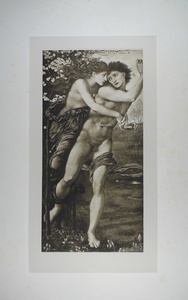| Method | Photogravure |
| Artist | after Sir Edward Coley Burne-Jones |
| Published | Published by the Berlin Photographic Company Berlin. _ London W.133 New Bond Street. _ New York 14 East 23rd Street. [c.1900] |
| Dimensions | Image 358 x 180 mm, Plate 431 x 241 mm, Sheet 667 x 507 mm |
| Notes |
Printed on India laid paper. Plate 2, taken from Burne-Jones' 1870 watercolour of the same title, from 'The Work of Edward Burne-Jones, Ninety-One Photogravures Directly Reproduced from the Original Paintings'. Only two-hundred copies of the 'The Work of Edward Burne-Jones...' were produced, each of which was signed by Philip Burne-Jones, the eldest son of Edward. Like many works produced by Pre-Raphaelite artists, Burne-Jones looked to literary sources for his 'Phyllis and Demophoon'. Two major works are referenced; Chaucer's 'Legend of the Good Women', and Ovid's 'Heroides'. Whilst the myth of Phyllis and Demophoon originally appeared in Ovid's poem 'Heroides', Chaucer, a significantly influential figure to the Pre-Raphaelites, recounted the legend of Phyllis as one of ten tales of virtuous women, told in the form of a dream vision, in his 'Legend of Good Women'. The legend witnesses the tragic heartbreak of Phyllis, Queen of Thrace, at the hands of Demphoon, King of Athens and son of Theseus. On his journey home following the Trojan War, Demophoon stops at Thrace, where he encounters Phyllis. The two marry, but duty bound, Demphoon returns to Greece to support his father, promising he will return in six months' time. Failing to keep his promise, heartbroken Phyllis hangs herself, and is converted into an almond tree by the gods. Eventually returning to Thrace, Demophoon remorsefully embraces the almond tree, bringing the tree into bloom. Phyllis emerges from the tree to forgive and reclaim her lover. The figures of both Phyllis and Demophoon were modelled on Maria Zambaco, the woman whom Burne-Jones had been having an affair with since June 1868. When the painting was exhibited at the Old Watercolour Society for the 1870 Summer Exhibition, great controversy followed, partially because of Burne-Jones' affair, but also as a result of Demophoon's nudity. Due to the numerous complaints, Burne-Jones withdrew the painting from the exhibition two weeks after the opening. In the August of the same year, Burne-Jones resigned from the Society. Sir Edward Coley Burne-Jones, 1st Bt (1833-1898) was a painter and designer closely associated with the later phase of the Pre-Raphaelite movement. Burne-Jones met William Morris as an undergraduate of Exeter College, Oxford, whilst studying for a degree in theology. The pair went on to work very closely together on numerous decorative arts projects including stained glass windows, tapestries, and illustrations. Originally intending to become a church minister, Burne-Jones never finished his degree, choosing instead to pursue an artistic career under the influence of Dante Gabriel Rossetti. Rossetti heavily inspired his early work, but by the 1860's his idiosyncratic style was beginning to develop. His mature work, however different in total effect, is rich in conscious echoes of Botticelli, Mantegna and other Italian masters of the Quattrocento. Thusly, Burne Jones' later paintings of classical and medieval subjects are some of the most iconic of the Pre-Raphaelite movement. He was at the height of his popularity during the 1880's, though his reputation began to decline with the onset of the Impressionists. He was created a baronet in 1894, when he formally hyphenated his name. The Berlin Photographic Company, (1880 - 1920; fl) or the Berlin Photographische Gesellschaft, was a German print publishers who specialised in photogravures after Old Masters and contemporary painters. High quality photographs were taken of the original works. The negatives were then exposed onto a gelatin covered copper plate, etched with acid, and printed in a similar fashion to an engraving. The main series of the Berlin Photographic Company's publications is kept together at Blythe House, West Kensington. Condition: Foxing and discolouration to margins, water stains to upper right and lower left corners, not affecting image. Small tear to lower edge of sheet. |
| Framing | unmounted |
| Price | £500.00 |
| Stock ID | 41485 |

